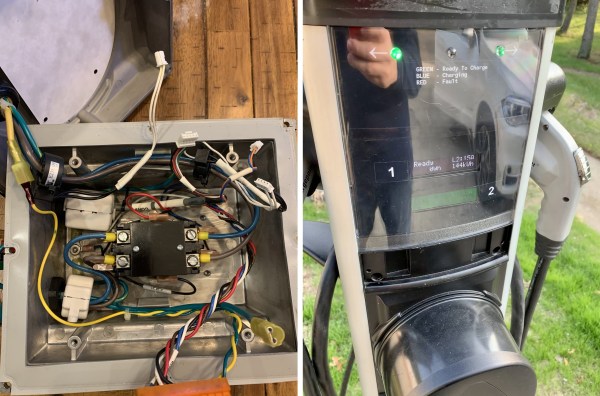One of the drawbacks of being an early adopter is that you might end up investing in equipment that becomes obsolete rather quickly. Although it’s clear that electric vehicles are here to stay, those who bought a charging station for their EV a few years ago may find it slow and incompatible with modern cars or billing networks, necessitating an upgrade to one of the latest models.
If you don’t mind tinkering, these older chargers can provide an excellent base to construct your own state-of-the-art charging station, as [James] over at Diary-of-a-Geek did. He bought a Chargepoint CT2000 series charger and installed a brand-new charging unit inside based on OpenEVSE components. The CT2000 is an older model that’s no longer manufactured, and although it can still connect to Chargepoint’s network, a subscription renewal would cost several thousand dollars. [James] was not willing to make that investment for a unit that he was going to install at home anyway, so he decided to buy replacement parts from OpenEVSE, a supplier of open-source EV charging stations and components.

The insides of a charging station are actually pretty simple, since the real battery charger is inside the car: the station just contains a beefy contactor to switch the AC current on or off, along with some circuitry to measure the current flowing and an interface to connect to a payment network of some sort. The first step therefore was to hook up the contactor and current transformer to the OpenEVSE controller. This was easy since the new part was way smaller than the original and could simply be mounted onto an existing bracket.
The second step was to provide the user interface and network connections. [James] removed the displays and wireless systems from the head unit and cut a large hole into the front to provide space for new LCD displays. A set of status LEDs plus WiFi connections completed the system, which now looks just as professional as the original. Tests showed that the LCDs were hard to read in bright sunlight, so [James] replaced them with OLED displays, but otherwise the renovated charging station worked perfectly.
Of course, working with high voltages and large currents requires the proper skills and tools, which [James] clearly has available; he also stresses the importance of including a ground-fault circuit interruptor in any equipment placed outdoors. He isn’t the only one to make his own charging station either. If you’re confused by the many types of EV charging connectors, have a look at our recent article describing all those different plugs and sockets. Thanks for the tip, [Kevin]!











